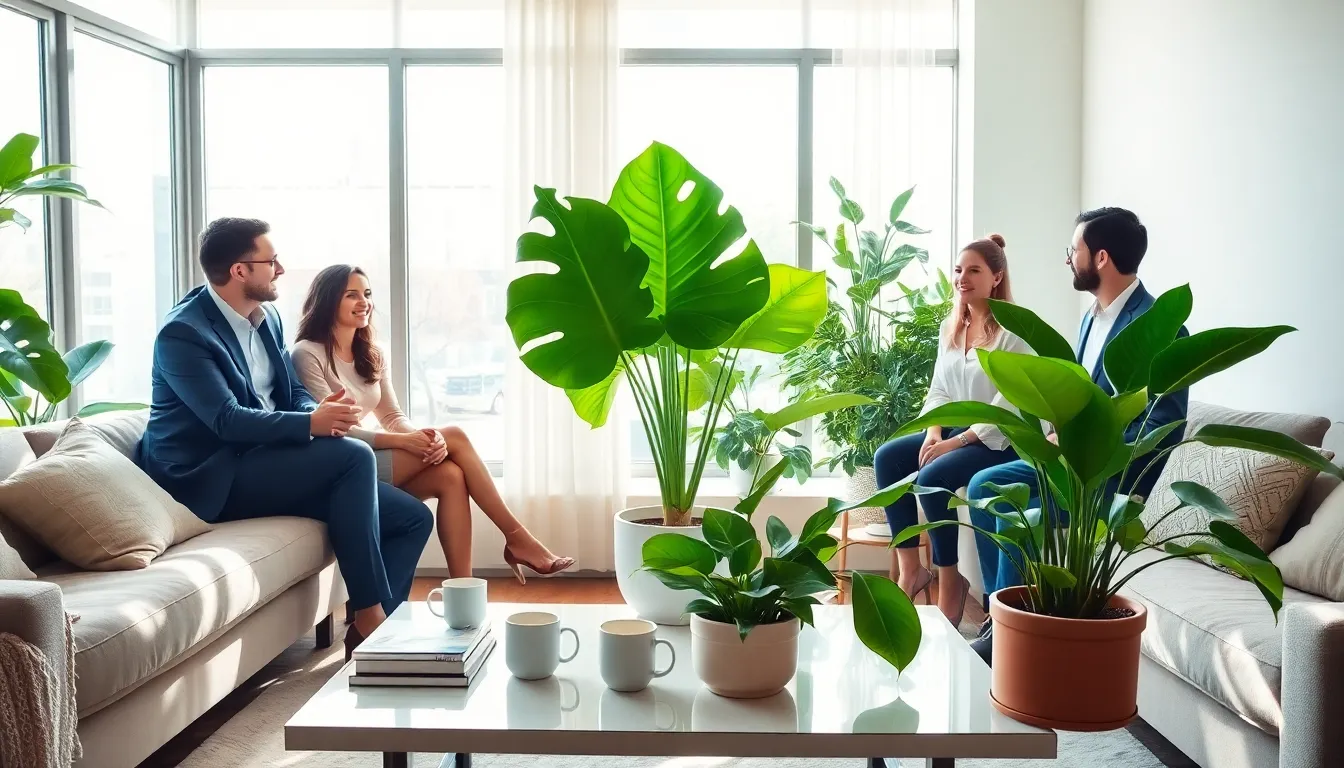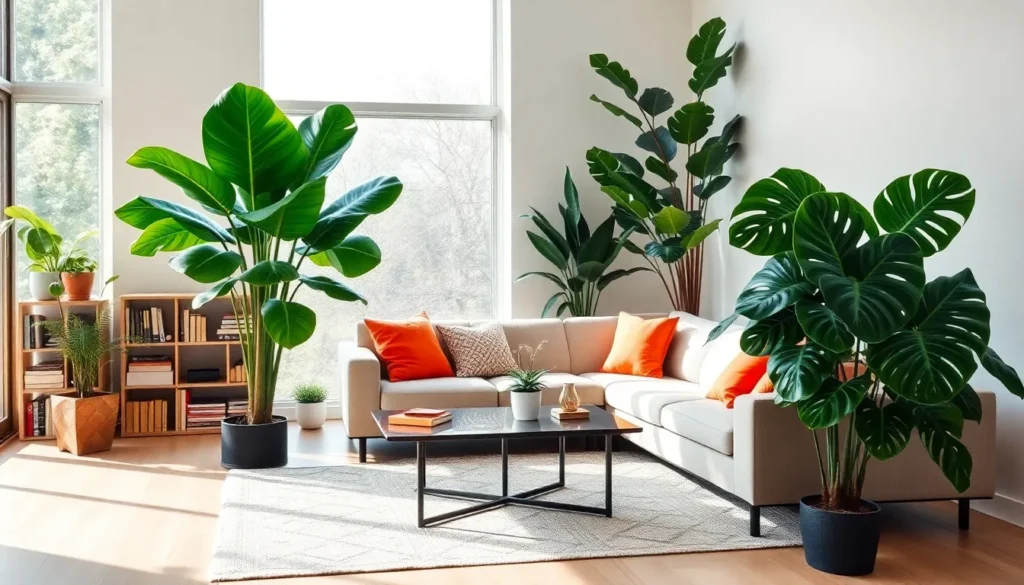When it comes to decorating a home, large indoor house plants are like the cherry on top of a sundae, deliciously delightful and guaranteed to elevate any space. Imagine walking into a room adorned with vibrant foliage, where each plant not only beautifies but also purifies the air. These leafy giants do more than just sit pretty: they work hard to enhance your living environment and boost your mood. In this guide, we’ll explore the myriad benefits of large indoor house plants, showcase some of the best options, and share invaluable tips for their care. So grab your watering can, because it’s time to turn your humble abode into a lush sanctuary.
Table of Contents
ToggleBenefits of Large Indoor House Plants

Enhancing Air Quality
Large indoor house plants are not just decorative: they can also significantly enhance air quality. Certain plants, like the popular Fiddle Leaf Fig and the resilient Snake Plant, are known for their ability to absorb toxins and release oxygen. Studies have shown that indoor plants can reduce common pollutants such as formaldehyde and benzene, making your home not just beautiful but also healthier.
Aesthetic Appeal and Decor
Let’s face it: who doesn’t love the look of a beautifully arranged living room filled with greenery? Large indoor house plants serve as striking focal points that can tie together your decor style, whether it’s modern, bohemian, or even minimalistic. They add color, texture, and life to empty corners, transforming them into cozy nooks. Plus, a well-placed plant can subtly direct attention, guiding the eye through your space.
Improving Mental Well-Being
Plants have a unique ability to uplift moods. Numerous studies suggest that indoor gardening or simply being around plants can reduce stress levels and assist in eliminating feelings of anxiety. Caring for these plants can create a sense of purpose, allowing individuals to disconnect from the hectic pace of life and reconnect with nature, even indoors.
Best Large Indoor House Plants
Fiddle Leaf Fig
No list of fabulous indoor plants would be complete without the Fiddle Leaf Fig. This beauty boasts large, glossy leaves that make a statement in any room. It thrives in bright, indirect light and can reach up to six feet tall, making it an excellent choice for filling empty spaces.
Rubber Plant
The Rubber Plant, with its striking dark green foliage, is known for its easy maintenance. It can tolerate low light conditions and doesn’t require constant attention. Plus, it can grow quite large, providing an instant boost to your indoor garden.
Monstera Deliciosa
Affectionately known as the Swiss Cheese Plant, the Monstera Deliciosa charms plant lovers with its unique leaf patterns. These monstera plants can grow anywhere from one to several feet tall, making them a bold choice for any home. They thrive in moderate to bright light and can even tolerate some neglect, making them perfect for busy lifestyles.
Snake Plant
Also known as Mother-in-Law’s Tongue, the Snake Plant is virtually indestructible. With its upright, sword-like leaves, it requires minimal attention and can tolerate low light and irregular watering. This makes it ideal for both beginners and seasoned plant enthusiasts.
Care Tips for Large Indoor House Plants
Lighting Requirements
Understanding the lighting needs of your plants is crucial. Many large indoor house plants thrive in bright, indirect light. But, some can adapt to lower light levels. Be sure to research each plant’s specific needs to ensure it receives the light it requires to flourish.
Watering and Humidity Needs
Watering can be a bit tricky: too much, and you risk root rot: too little, and your plants will suffer from dehydration. Most large house plants prefer the soil to dry out slightly between waterings. Also, keeping humidity levels in check is essential, particularly in dry conditions. Consider misting your plants or placing a humidifier nearby during winter.
Soil Type and Fertilization
Choosing the right soil type can make all the difference. Look for well-draining potting mixes enriched with organic matter. Regular fertilization during the growing season promotes healthy growth, just remember to avoid over-fertilizing, which can lead to nutrient burn.
Common Pests and Solutions
Identifying Pests
Even the most diligent plant parent may encounter pests. Common offenders include spider mites, aphids, and mealybugs. Regularly inspect your plants for signs of pests, such as stippling on leaves or webbing, to take action swiftly.
Preventative Measures
The best pest control is prevention. Ensuring good air circulation around your plants and avoiding overcrowding will help keep pests at bay. Also, keeping your plant leaves clean can deter many unwanted invaders.
Eco-Friendly Pest Control Solutions
If pests do make an appearance, don’t panic. There are plenty of eco-friendly solutions available, from neem oil sprays to insecticidal soap. Both options are effective and less harmful to beneficial insects, allowing you to tackle pest issues without resorting to harsh chemicals.
Creating the Perfect Environment
Choosing the Right Location
Finding the ideal spot for large indoor house plants can dramatically affect their health and growth. Look for areas that receive appropriate light while also considering the draft and temperature extremes that could stress your plants.
Complementing Home Decor
Think about how the colors and shapes of your plants can enhance your existing decor. For example, a tall Monstera or a broad Fiddle Leaf Fig can juxtapose beautifully against a backdrop of minimalist decor, breathing life and character into your home.
Seasonal Considerations
Preparing for Winter
As winter approaches, indoor conditions can become challenging for plants. Many people should reposition plants away from cold windows and give them extra humidity to combat dry indoor air. It’s also a good time to reduce watering as many plants enter a dormant phase.
Summer Maintenance Tips
During the summer months, keep an eye on how much light your plants receive. Too much direct sunlight can scorch leaves. Regularly check soil moisture levels, as plants tend to drink more in warmer conditions.

